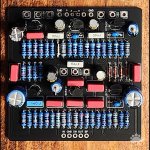Fingolfen
Well-known member
- Build Rating
- 5.00 star(s)
Yeah... ya'll knew this one was coming...
I've wanted to do a real Cornish P-2 clone for ages, but the only board I could find was the Effects Layouts version, which had the "probably" disclaimer and appears to have been based some speculative circuit diagrams on the net. I'd built a few pedals using hand-etched boards, both with and without the effects layouts Cornish buffer, and had really loved the sound. I still wanted to have a faithful clone of the original, though, and with a littlegentle dino-sized nudging, PedalPCB has recently released the Polonium-2 board based on a trace of the actual P-2 pedal itself.

(For a Pachycephalosaurus this counts as a "gentle nudge")
While Cornish pedals are very expensive, and there are apparently restrictions on reverse engineering the pedal if you buy directly from Cornish, that doesn't seem to have stopped the designs from getting out into the wild through clones. The image below appears to be a PCB which would be shared between the P-2 and the G-2 pedals, which makes the absence of a P-2 board until now even more confusing in some ways. That being said, the PedalPCB board was certainly worth the wait!

As you can see from the image below, the PedalPCB Polonium-2 board is extremely well laid out and compact. Honestly I don't know how he gets them that compact, but it is amazing. Having the resistors in neat rows makes soldering very easy as even if you populate large chunks of the layout at a time as the bent leads aren't going to substantially interfere with your ability to get the tip and solder where you need it!

As with all of my modern builds, I'm using 1% metal film 1/4 Watt resistors from Yageo and KOA Speer. I even found a 1% 10M Ohm resistor at Mouser, but they're a lot more expensive than the rank and file resistors. The film capacitors are WIMA and KEMET and all of them are 5% tolerance, apart from one 220nF which is a 10% tolerance. The electrolytic capacitors are a mix of Nichicon and Vishay. I was out of 22uF radial capacitors, but there was plenty of room for me to just use some axial ones with the negative lead bent over the top. The diodes are modern production 1N4148s, and the transistors are all BC549C.

In the standard drill pattern the LED is located between the top two potentiometer knobs. I wanted to retain this position as it worked for the overall enclosure design, but I also wanted to use some diffused golden / yellow LEDs with short leads. As these would not reach the connection point on the PCB, I went ahead and hand wired the LED to the board. I'm using ribbon cable to attach the main PCB to the buffered version of the 3PDT daughter board (thanks to @Phil hodson and @DGWVI for helping me source these!). The rest of the wiring is very straightforward. All of the jacks are grounded to the main PCB and all of the connections to the jacks are insulated with heat shrink tubing.

I'd worked up a cool Protoceratops enclosure for the Effects Layout version of this board, but the knob and LED layout on the PedalPCB board is very different from that board, so I created a similar one for the definitive "Protoceratops 2." It's just put together with a few pieces of licensed stock art, but I like the overall effect. As the image itself is fairly antiqued, I went with a cream rather than white enclosure, which meant I needed to have a white layer underneath the graphics to ensure they weren't darkened out by the enclosure. After a little trial and error I also decided to go with cream knobs as well as they seem to work well with the design.
In terms of the sound, it retains all of the gain and brightness of the actual P-2. The gain level, even at low sustain levels, completely outstrips what I get from my recent Gilmour Ram's Head build, but that is likely due to the gain of the transistors themselves (which I absent mindedly forgot to measure before I put them in the circuit!). I need to order some more BC549C transistors as each of these builds requires six, and I'll get a better idea of where they sit then. Now that I have this one together, my plan is to pull out the Effects Layout P-2 "probably" build and compare the tone between the two and hopefully get a demo together.
A bit more (mostly background and preamble) at the blog: https://steggostudios.blogspot.com/2023/03/cloning-cornish-p-2-for-real-this-time.html
I've wanted to do a real Cornish P-2 clone for ages, but the only board I could find was the Effects Layouts version, which had the "probably" disclaimer and appears to have been based some speculative circuit diagrams on the net. I'd built a few pedals using hand-etched boards, both with and without the effects layouts Cornish buffer, and had really loved the sound. I still wanted to have a faithful clone of the original, though, and with a little

(For a Pachycephalosaurus this counts as a "gentle nudge")
While Cornish pedals are very expensive, and there are apparently restrictions on reverse engineering the pedal if you buy directly from Cornish, that doesn't seem to have stopped the designs from getting out into the wild through clones. The image below appears to be a PCB which would be shared between the P-2 and the G-2 pedals, which makes the absence of a P-2 board until now even more confusing in some ways. That being said, the PedalPCB board was certainly worth the wait!

As you can see from the image below, the PedalPCB Polonium-2 board is extremely well laid out and compact. Honestly I don't know how he gets them that compact, but it is amazing. Having the resistors in neat rows makes soldering very easy as even if you populate large chunks of the layout at a time as the bent leads aren't going to substantially interfere with your ability to get the tip and solder where you need it!

As with all of my modern builds, I'm using 1% metal film 1/4 Watt resistors from Yageo and KOA Speer. I even found a 1% 10M Ohm resistor at Mouser, but they're a lot more expensive than the rank and file resistors. The film capacitors are WIMA and KEMET and all of them are 5% tolerance, apart from one 220nF which is a 10% tolerance. The electrolytic capacitors are a mix of Nichicon and Vishay. I was out of 22uF radial capacitors, but there was plenty of room for me to just use some axial ones with the negative lead bent over the top. The diodes are modern production 1N4148s, and the transistors are all BC549C.

In the standard drill pattern the LED is located between the top two potentiometer knobs. I wanted to retain this position as it worked for the overall enclosure design, but I also wanted to use some diffused golden / yellow LEDs with short leads. As these would not reach the connection point on the PCB, I went ahead and hand wired the LED to the board. I'm using ribbon cable to attach the main PCB to the buffered version of the 3PDT daughter board (thanks to @Phil hodson and @DGWVI for helping me source these!). The rest of the wiring is very straightforward. All of the jacks are grounded to the main PCB and all of the connections to the jacks are insulated with heat shrink tubing.

I'd worked up a cool Protoceratops enclosure for the Effects Layout version of this board, but the knob and LED layout on the PedalPCB board is very different from that board, so I created a similar one for the definitive "Protoceratops 2." It's just put together with a few pieces of licensed stock art, but I like the overall effect. As the image itself is fairly antiqued, I went with a cream rather than white enclosure, which meant I needed to have a white layer underneath the graphics to ensure they weren't darkened out by the enclosure. After a little trial and error I also decided to go with cream knobs as well as they seem to work well with the design.
In terms of the sound, it retains all of the gain and brightness of the actual P-2. The gain level, even at low sustain levels, completely outstrips what I get from my recent Gilmour Ram's Head build, but that is likely due to the gain of the transistors themselves (which I absent mindedly forgot to measure before I put them in the circuit!). I need to order some more BC549C transistors as each of these builds requires six, and I'll get a better idea of where they sit then. Now that I have this one together, my plan is to pull out the Effects Layout P-2 "probably" build and compare the tone between the two and hopefully get a demo together.
A bit more (mostly background and preamble) at the blog: https://steggostudios.blogspot.com/2023/03/cloning-cornish-p-2-for-real-this-time.html
Last edited:

